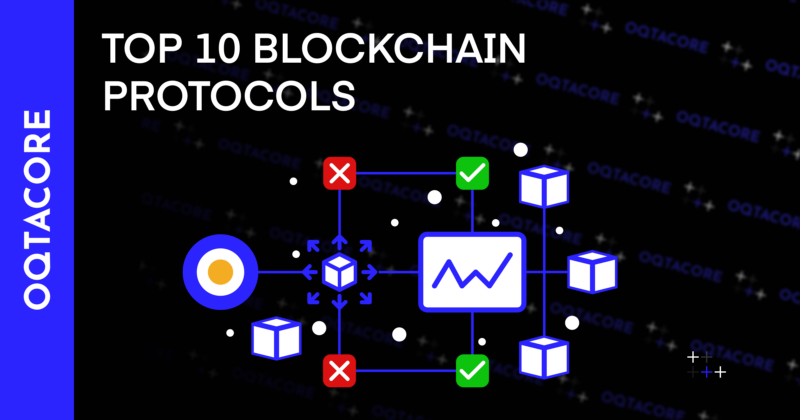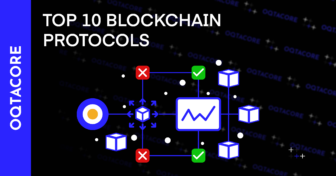
Explore the leading blockchain protocols of 2025, enhancing scalability, security, and interoperability for a decentralized future.
Introduction
The blockchain landscape is evolving faster than ever. In 2025, leading protocols are pushing the boundaries of scalability, security, interoperability, and real-world adoption.
The era of monolithic chains is over – today’s most innovative blockchains leverage Layer-2 scaling, modular architectures, and AI-driven automation to deliver faster, cheaper, and more efficient transactions.
This article explores the 10 most influential blockchain protocols in 2025, analyzing their core innovations, adoption trends, and future potential.
1. Ethereum (ETH) – The Smart Contract Standard
Category: Layer-1 + Layer-2 Rollups
Key Innovation: Danksharding, Proto-Danksharding (EIP-4844), Layer-2 Expansion
Why It Leads: Largest developer ecosystem, DeFi hub, and continuous scaling improvements
Ethereum remains the foundation of the decentralized economy. With Layer-2 solutions like Arbitrum, Optimism, and zkSync now processing millions of transactions at low cost, Ethereum’s dominance is set to continue.
What’s Next?
- Full sharding implementation for infinite scalability
- Decentralized MEV solutions to reduce front-running
- Expansion of AI-integrated smart contracts
Ethereum is not just maintaining its lead – it is redefining decentralized applications and financial systems.
2. Solana (SOL) – The High-Throughput Challenger
Category: High-Performance Layer-1
Key Innovation: Firedancer (Independent Validator Client), State Compression for NFTs
Why It Leads: 400ms block times, low fees, and a growing DeFi and NFT ecosystem
Solana has solidified its position as Ethereum’s fastest competitor. Its Firedancer validator client, developed by Jump Crypto, has made the network more resilient and scalable than ever.
What’s Next?
- Expansion of Solana-based DeFi and liquidity pools
- Institutional adoption for on-chain finance
- Scalable NFT ecosystems with cost-efficient transactions
With growing developer activity and improved network stability, Solana is a leading force in high-performance blockchain infrastructure.
3. Bitcoin (BTC) – From Digital Gold to Financial Layer
Category: Layer-1 + Layer-2 Scaling
Key Innovation: Ordinals, Bitcoin DeFi (BitVM, Stacks, Runes)
Why It Leads: Largest market cap, store of value, and growing DeFi ecosystem
Bitcoin’s evolution extends beyond a store of value. BitVM and Ordinals have introduced smart contract capabilities, enabling DeFi applications on Bitcoin without compromising security.
What’s Next?
- Expansion of Bitcoin Layer-2s (Lightning, Ark, Runes)
- Growth of Bitcoin-native DeFi protocols
- Institutional adoption through spot ETFs
Bitcoin is proving that security and decentralization can coexist with innovation.
4. Polygon (MATIC) – The Layer-2 Powerhouse
Category: Layer-2 Scaling for Ethereum
Key Innovation: Polygon zkEVM, AggLayer (Unified L2s)
Why It Leads: Scalability, enterprise adoption, and Ethereum-native integration
Polygon has become a key player in Ethereum’s scaling ecosystem. With zkEVM rollups and AggLayer, it is creating a seamless multi-chain experience for developers and users.
What’s Next?
- More enterprise blockchain adoption (Nike, Starbucks, Reddit)
- Expansion of Polygon zkEVM rollups
- AggLayer adoption across Layer-2 networks
Polygon continues to be the most widely adopted Ethereum Layer-2 solution.
5. Avalanche (AVAX) – The Custom Blockchain Ecosystem
Category: Layer-1 + Subnets
Key Innovation: HyperSDK, Institutional & Gaming Subnets
Why It Leads: Modular scaling, institutional adoption, and gaming infrastructure
Avalanche’s Subnet architecture has made it a go-to choice for enterprises, Web3 gaming, and financial applications requiring high throughput and customizable blockchains.
What’s Next?
- Institutional adoption of financial subnets
- Expansion of HyperSDK for custom blockchain deployment
- Growth in gaming and NFT infrastructure
Avalanche is proving that modular blockchain design is the future of scalable ecosystems.
6. Cosmos (ATOM) – The Internet of Blockchains
Category: Layer-1 + Interoperability
Key Innovation: Interchain Security, Cosmos 2.0
Why It Leads: Seamless cross-chain communication and modular blockchain growth
Cosmos is the leader in interoperability and cross-chain security, with over 50 interconnected blockchains using its IBC (Inter-Blockchain Communication) protocol.
What’s Next?
- Expansion of Interchain Security to secure more chains
- Growth of modular blockchain frameworks
- Enhanced DeFi and AI-powered applications
Cosmos is the backbone of the cross-chain economy, enabling a seamless flow of assets and data across multiple ecosystems.
7. Near Protocol (NEAR) – AI-Driven Smart Contracts
Category: Layer-1
Key Innovation: AI-Integrated Blockchain Solutions
Why It Leads: Fast execution, AI-powered smart contracts, and sharding scalability
Near is pioneering the integration of AI into blockchain, allowing for machine learning-driven smart contracts that automate complex transactions.
What’s Next?
- AI-powered blockchain automation
- Expansion of Nightshade sharding for higher scalability
- Growth in DeFi and decentralized identity solutions
With AI-driven applications gaining momentum, Near is leading the next wave of blockchain evolution.
8. Sui (SUI) – The Object-Oriented Blockchain
Category: Layer-1 + Move Programming
Key Innovation: High-Performance Modular Blockchain Architecture
Why It Leads: Ultra-fast transactions and advanced data handling for DeFi and gaming
Sui’s Move-based programming model makes it one of the most efficient and scalable blockchains for real-world applications.
What’s Next?
- Expansion of DeFi applications on Sui
- Increased adoption in Web3 gaming and digital assets
- Modular blockchain growth for enterprise use cases
Sui is redefining how assets and smart contracts interact in a scalable and efficient way.
Final Thoughts
Blockchain innovation in 2025 is defined by scalability, interoperability, and real-world use cases. The top protocols are no longer competing just on transaction speeds but on infrastructure reliability, security, and enterprise adoption.
- Ethereum remains the industry standard, continuously evolving through Layer-2 advancements.
- Bitcoin is transforming beyond a store of value, becoming a programmable financial layer.
- AI-driven and modular blockchains like Near and Sui are shaping the next era of Web3 applications.
As blockchain adoption accelerates, businesses and developers need secure, scalable, and future-ready solutions to stay ahead.
Building the Future of Blockchain with OQTACORE
At OQTACORE, we build more than software – we engineer digital evolution. Since 2013, we’ve been at the forefront of emerging technologies, delivering 50+ transformative projects across industries.
Build. Scale. Lead the Digital Future.
